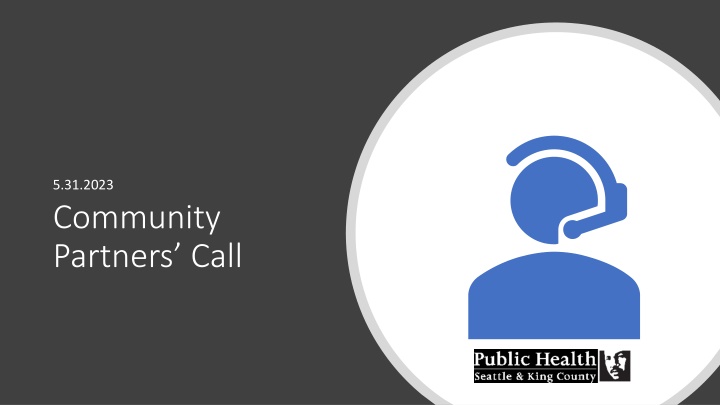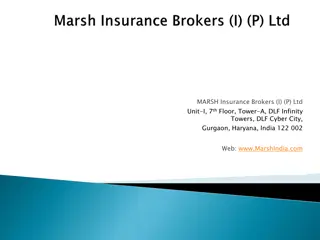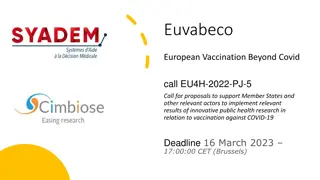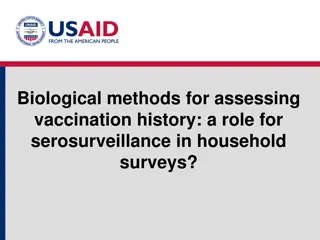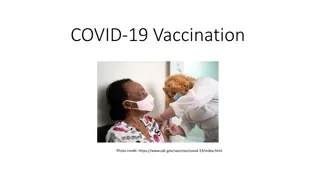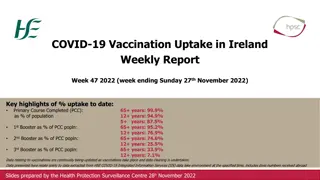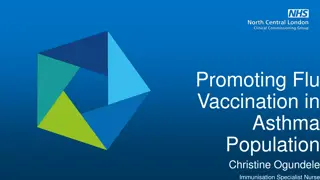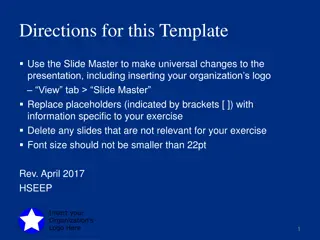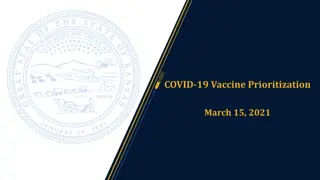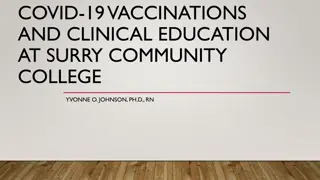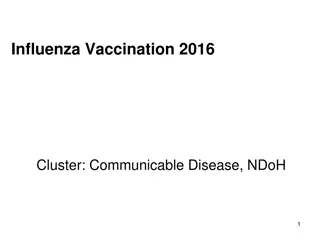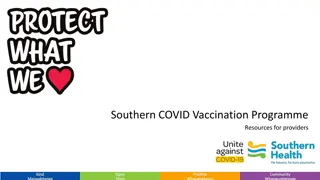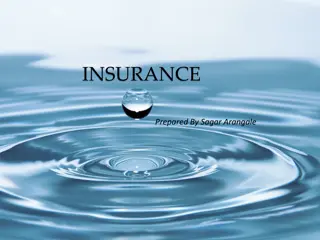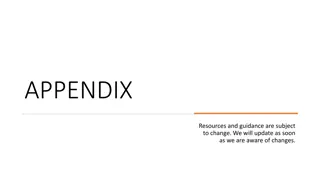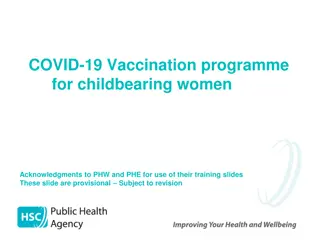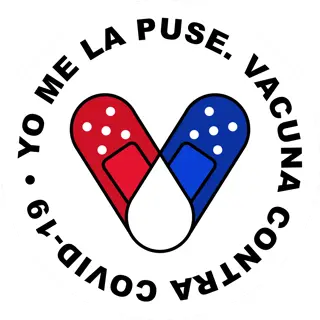COVID-19 Testing, Vaccination, and Insurance Updates
Information regarding where to access COVID-19 tests, the availability and potential costs of vaccines and antiviral treatments, and the need for some individuals to re-enroll for Apple Health (Medicaid) coverage as the federal emergency declaration ends. Details on costs, locations, and assistance options are provided.
Download Presentation

Please find below an Image/Link to download the presentation.
The content on the website is provided AS IS for your information and personal use only. It may not be sold, licensed, or shared on other websites without obtaining consent from the author.If you encounter any issues during the download, it is possible that the publisher has removed the file from their server.
You are allowed to download the files provided on this website for personal or commercial use, subject to the condition that they are used lawfully. All files are the property of their respective owners.
The content on the website is provided AS IS for your information and personal use only. It may not be sold, licensed, or shared on other websites without obtaining consent from the author.
E N D
Presentation Transcript
5.31.2023 Community Partners Call
Where to get COVID-19 tests? COVID at home test kits are available at all Pharmacy's for a cost. Ranging from 10-25 dollars a box. Doctors' offices and Pharmacy's. Check with your heath insurance to see the out-of-pocket costs. Many health plans offer free and low-cost access to test kits If you are an organization and need at home test kits; Public Health has access to test kits still until the end of summer. Please email phpartnerships@kingcounty.gov
Potential costs for COVID-19 vaccine and antiviral treatments COVID-19 vaccines and antiviral treatment are currently free to the public. They will remain free, even for people who don t have insurance, as long as the federal government s large supply of vaccine and medication lasts. Vaccines purchased by the federal government are predicted to last through the summer and COVID-19 treatments will remain available, depending on the product, through the end of the year. After these free federal supplies run out, COVID-19 vaccines and treatments will shift to the private market.
Potential costs for COVID-19 vaccine and antiviral treatments Getting a COVID-19 vaccine will likely be similar to getting the annual flu shot and other routine vaccines. COVID-19 shots and boosters will continue to be free for children under 18 years (through the Washington Childhood Vaccine Program and Children s Health Insurance Program). In addition, most commercial insurance, Medicare, and Medicaid programs will cover the vaccines for their members. Starting later this year, people will likely have out-of-pocket costs for COVID-19 treatment, depending on the type of insurance they have. This would be similar to the costs people have for other drugs through traditional coverage. The federal government is working with vaccine and treatment manufacturers to ensure that Patient Assistance Programs that provide free access to these products are easy to use and broadly accessible.
Some people may need to re-enroll for Apple Health (Medicaid) coverage The COVID-19 federal emergency declaration temporarily prevented anyone from losing their Apple Health (Medicaid) insurance, even if their income increased and they were no longer eligible. With the order ending this spring, some people will be required to complete a renewal application to keep their Apple Health coverage In the coming months, Apple Health users may receive a letter from the state with renewal instructions, and they must respond within 60 days. Now is a good time for all Apple Health users to make sure their mailing address and email are up to date with Apple Health at WAHealthPlanFinder.org Public Health will be working with community partners in the coming weeks to conduct outreach and assist anyone who may be at risk of losing their Apple Health Public Health insurance navigators are available to help assist you with information on affordable healthcare options and enrollment: 1-800-756-5437, www.kingcounty.gov/chap
Treatment When the federal supplies of antiviral medications run out later this year, people will likely have out-of-pocket costs for COVID- 19 treatment, depending on the type of insurance they have. This would be like the costs people have for other drugs through traditional coverage COVID-19 antiviral medications such as Paxlovid purchased by the federal government will remain free regardless of insurance coverage until supplies run out
Generally, Generally, COVID COVID- -19 burden is burden is decreasing in the decreasing in the US and here in US and here in King County. King County. 19
In King In King County, our County, our current trends current trends show the show the following: following:
Keep in mind Keep in mind Public Health
Keep in mind Keep in mind PUBLIC HEALTH RECEIVES DATA FROM PEOPLE WHO SEEK OUT TESTING. CASE COUNTS BECOME LESS RELIABLE. WE TURN TO HOSPITALIZATIONS AND DEATH DATA FOR DISEASE BURDEN
COVID COVID- -19 hospitalizations occur disproportionately in older age groups. (Average 7 19 hospitalizations occur disproportionately in older age groups. (Average 7 day rate in the last 28 day period. day rate in the last 28 day period.
COVID-19 vaccinations remain a key part of public health intervention. Hospitalizations . ,l Deaths . ,l ?Long COVID . ,l
We have had great success with primary vaccines. We have had great success with primary vaccines. (over the past month we have increased our (over the past month we have increased our vaccine rate by .1% vaccine rate by .1%
But we have a lot more work to do to bring But we have a lot more work to do to bring people up to date. people up to date.
Vaccine preventable infections COVID-19 Annual boosters made available in the fall Allows for updates based on the circulating variants Booster will provide the extra immunity protection especially for those at highest risk for severe disease
Bivalent (Omicron) Booster
New Updated Bivalent Booster Who is now eligible to receive the second bivalent booster? People ages 65 and over. o People over 65 are among those most susceptible to severe outcomes from Covid-19. o These individuals are newly able to receive their second bivalent booster if it s been at least 4 months since their first bivalent shot. People who are immunocompromised. o The new guidance from the CDC is that anyone 6 and older with moderate or severe immunocompromise can receive a second bivalent booster if it s been at least two months since their first. o Depending on their specific medical circumstances, they may be able to receive the bivalent booster as frequently as every two months. They can talk with their provider about this and see if it s right for them.
CDCs new recommendations allow an additional updated (bivalent) vaccine dose for adults ages 65 years and older and additional doses for people who are immunocompromised. This allows more flexibility for healthcare providers to administer additional doses to immunocompromised patients as needed. Monovalent (original) mRNA COVID-19 vaccines will no longer be recommended for use in the United States. CDC recommends that everyone ages 6 years and older receive an updated (bivalent) mRNA COVID-19 vaccine, regardless of whether they previously completed their (monovalent) primary series. Individuals ages 6 years and older who have already received an updated mRNA vaccine do not need to take any action unless they are 65 years or older or immunocompromised. For young children, multiple doses continue to be recommended and will vary by age, vaccine, and which vaccines were previously received. Continued.
The best way to protect yourself from XBB.1.5 subvariant of Omicron is to get vaccinated and stay up to date on COVID-19 vaccines. Staying protected against new Variants Important to assess your risk level and keep that top of mind. If you will be around others in an indoor setting, consider wearing a mask. But not just any mask will do. It is important to wear an N95 or KN95 mask for the best protection. Avoid poorly ventilated spaces and maintain physical distancing from others. And if you feel sick, stay home and get tested to determine the best course of action.
Part 2 Public Health updates
HOW TO PREPARE FOR AN EARLY AND LONG 2023 WILDFIRE SEASON IN KING COUNTY
Continued: 1.Stay safe indoors and avoid outdoor exercise when the air quality index (AQI) is above 150. Check local AQI at PSCleanAir.org, and 5-day smoke forecasts at WAsmoke.blogspot.com. 2.People with asthma, heart and lung conditions, or diabetes should move indoors when AQI is above 100, and keep inhalers and medications on hand. Children, adults ages 65 and over, and pregnant people are also at higher risk from smoke. 3.Close windows and doors on smoky days. Create a clean air room using a HEPA or DIY box fan filter. Run AC if you can, or move to a mall, library, cooling shelter, or other air-conditioned building if it becomes too hot.
List: Here's where you can cool down in western Washington this weekend as it heats up | KOMO (komonews.com) Cooling Center Link
What is Fentanyl? Fentanyl is a potent synthetic opioid drug approved by the Food and Drug Administration for use as an analgesic (pain relief) and anesthetic. It is approximately 100 times more potent than morphine and 50 times more potent than heroin as an analgesic. Fentanyl Drug related death investigations account for approximately 35% of the King County Medical Examiner s Office death investigation case load. 507 deaths have been certified as fatal drug overdoses in King County, WA.
We have seen fentanyl primarily in two forms: How are we seeing fentanyl? Pill generally a 100 milligram pill that contains 1-3% fentanyl, the remainder contains acetaminophen. Powder/Rock fentanyl percentages vary 8.5% to 37.8% The preferred method of use we continue to see if smoking , it accounts for 49% of known use for the fatal population We also see smoked and snorted fatal methods.
Numbers by the year: Fatal Overdoses (all drugs) by year 2016-present 1015 732 530 507 453 437 399 360 2016 2017 2018 2019 2020 2021 2022 2023
Numbers by the year: Fatal Fentanyl Overdoses by year 2016-present 709 413 389 172 112 66 33 22 2016 2017 2018 2019 2020 2021 2022 2023
Resources Overdose prevention and response - King County Find Naloxone Near You | Stopoverdose.org Bupe Pathways program reduces illicit opioid use and improves quality of life PUBLIC HEALTH INSIDER
Honoring Juneteenth is an important way to commemorate the emancipation of enslaved African Americans and celebrate their freedom. Juneteenth, also known as Freedom Day or Emancipation Day, is observed on June 19th each year in the United States. Juneteenth is not only a day of celebration but also a reminder of the ongoing fight for racial equality and social justice. By honoring Juneteenth, you contribute to the larger conversation and collective efforts towards a more inclusive and equitable society. Juneteenth
Celebrating Juneteenth King County honored and continues to honor Juneteenth as an opportunity to shine a light on the power of our Black community s health, strength, resiliency and beauty. In historical terms, Juneteenth is significant since it represents the delayed justice for Black Americans in our region and country a justice that we are still striving for in terms of health, education, the economy and more. President Abraham Lincoln signed the Emancipation Proclamation on January 1, 1863, declaring enslaved Black people in Confederate-controlled areas were free. However, it wasn t until Juneteenth June 19, 1865, two and a half years later that Major General Gordon Granger and around 10,000 Union soldiers, including the combined New York 26th and 31st Regimes of the U.S. Colored Troops, arrived in Galveston Bay, Texas to announce and enforce General Order #3, that the war was over and slavery had ended.
Recognizing and supporting Pride Month is a wonderful way to show solidarity with the LGBTQ+ community and celebrate their identities, experiences, and contributions. Pride Month is observed in June each year and serves as a time to commemorate the Stonewall Riots, which took place in June 1969 and marked a pivotal moment in the fight for LGBTQ+ rights. Pride Month
1. Trans Lifeline Peer support services, hotline, and resources for transgender people. 2. The Trevor Project | For Young LGBTQ Lives 3. API Chaya - Free, confidential, and culturally relevant hotline available to offer referrals, information, safety planning, and support for all languages. Focuses on supporting those impacted by domestic violence, sexual assault, and human trafficking within the South Asian, Asian, Pacific Islander, and LGBTIQ communities.1-877- 922-4292 4. BGLAD | Supporting LGBTQ+ at Youth Eastside Services Support for LGBTQ+ Youth 5. Welcome Home - Gay City: Seattle's LGBTQ Center 6. LGBTQ Youth Resources Lambert House 7. Peer Seattle | LGBTQ Peer Support | Seattle Anonymous HIV screening 8. Gender Clinic - Seattle Children s (seattlechildrens.org) - Cares for children, adolescents, and youth whose gender identity is different from their sex at birth and do not identify with traditional definitions of male or female 9. Home - Gender Justice League 10.Lifelong Local non profit 11.REFUGE Restrooms - Refuge Restrooms is a web application that seeks to provide safe restroom access for transgender, intersex, and gender nonconforming individuals Resources:
Basic Food/SNAP: King Countys Access and Outreach Team can help you apply and answer questions about Washington State s Basic Food program. Call the Community Health Access Program (CHAP): at 1-800-756-5437. SNAP Market Match and SNAP Produce Match: You can stretch Basic Food benefits by purchasing fresh vegetables and fruit at participating farmers markets. Visit SNAP Market Match, email SNAP.MarketMatch@doh.wa.gov, or call 360- 236-3148. Also available is SNAP Produce Match, a program where shoppers who use Basic Food benefits can stretch their food budget to buy more fruits and vegetables at participating grocery stores and online. Visit the website at SNAP Produce Match, email SNAP.ProduceMatch@doh.wa.gov, or call 360-236-3148. Women, Infants, and Children (WIC) Supplemental Nutrition Program: The WIC program provides families with healthy food, nutrition counseling, and breastfeeding support. You may be eligible for WIC if you are pregnant or postpartum, have an infant, or child under age 5. To learn more, see Public Health WIC Services, or call 206-263-9300. Senior Farmers Market Nutrition Program: You can find nutrition resources for older adults, including senior congregate meal locations and information about applying for an $80 e-benefit card to purchase fruits and vegetables at participating farmers markets here: agingkingcounty.org/what-we-do/healthy- aging/#sfmnp. Applications open on April 10, 2023. You can also call Community Living Connections at 206-962-8467 or (toll-free) 1-844-348-5464. FOOD INSECURITY IN KING COUNTY REMAINS HIGH: HOW TO HELP AND GET FOOD ASSISTANCE
School Meals and Summer EBT: Families can apply for free or reduced-price school meals for their children at any time during the school year by applying directly through their school or school district. School children who receive free or reduced-price school meals qualify for up to a $120 e-benefit card to purchase food during the summer months. Seattle Fresh Bucks: Eligible Seattle residents with household income below 80% area median income can enroll in the Fresh Bucks program to receive $40 in vouchers a month by mail. The vouchers, allow participants to buy any qualifying fruit and vegetable at any participating retailer including farmers markets, Seattle Safeways, and participating Seattle neighborhood grocers and farm stands. See Seattle Fresh Bucks or call 206-684-2489 for more information. Food Banks and Meal Programs: Many food banks now offer home delivery services and other conveniences like online ordering and curbside pick-up. Before going to your local food bank or meal program, call ahead to confirm their hours and to make an appointment, if necessary. Find your closest food bank or meal program by visiting this list and map of food resources. More locations
Next Meetings: July 26th 3:30-5pm August 23rd 3:30-5pm
